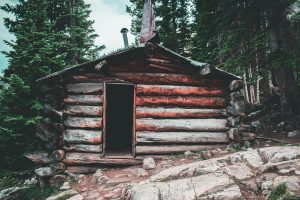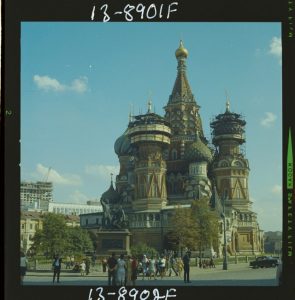Snow is falling, but I am not in a white world. At the Anchorage airport, broad-faced natives move through the lobby with the weary look of the world’s indigenous; Pacific-rim Asians with deal-making cell phones dial home; and an African-American running a shoe-shine booth polishes another pair of Rockports. Sled dogs in animal carriers howl like wolves caught in snares, their pleas echo through the concourse and outdoors into the Chugach Mountains. Outside, whatever light gets through the heavy cloud cover seems unhealthy. It’s the end of March, but the feeling more closely resembles a non-ending February, somewhere at the jumping off point at the north end of the earth—the edge of what’s known. Where I’m going is another plane ride away on Kodiak Island, where there are 3,000 brown bears and around 10,000 humans.
Hazel, an airport travel assistant, unfolds a map of this giant state and warns me, “Watch out for the bears on Kodiak. They’re awake you know.”
I tease her. “What if I find a cute cub? Can I pick him up?”
She doesn’t think I’m funny. “Only if you want to end up in the obituaries of the newspaper.”
I have traveled to Alaska to profile an emergency room doctor on Kodiak Island. Here in Anchorage I’m four time zones from Wall Street, 1,500 miles away from Seattle, as far north as Helsinki, and as far west as Honolulu. Out there in the bush are the sleds and the mushers and the mail planes that drop from the sky to land on perma frost and ocean surf. The Lower Forty-Eight has 6,000 miles of coastline; Alaska has 33,000. Alaska is water, glaciers, mountains, muskeg and, every second, ice melting beneath a warming planet.
In the dimly lit, lower level of the airport are glass cases of stuffed trumpeter swans, Dall sheep, and brown bear-sterile remnants of Alaska’s bounty. That bounty may be endless in reputation, but cod fishermen come back with less and less each year; loggers strip entire islands of old growth trees; Alaska’s killing fields of trappers and trophy hunters are legendary. And there’s still so much more, at least for the next few quick decades. This is our Outback, our own private Amazon—the last wild place we can act out our antiquated Robinson Crusoe wilderness fantasies, or escape from ex-wives, child support, and other tragedies that occur Down Below.
Only six hundred thousand people live up here and after two years of residency every man, woman, and baby receives a check from the Alaska Permanent Fund, their share of the Alaska’s oil profits. This year that amounts to $1,606.
Near the PenAir ticket counter, dialects drift in and out like steam in a dream. Native girls giggle and line up for Starbuck’s mochas. The clerk might be from a village in Nepal or Tibet. She might be Hindu or Muslim, and once wore a sari, but now she is dressed in a crisp Starbuck’s apron. She jockeys an espresso machine like a veteran and asks us the most important question of the moment. “Do you want two percent, soy, or whole milk?”
A native woman in mukluks strides past in a full-length sealskin coat with fur trim. At the BP ticket counter, several dozen rough-looking oil workers with duffel bags and dirty Cathartt sweatshirts wait in line for their ticket packets for the flight up to Deadhorse at Prudhoe Bay. Local newspaper columns and letters-to-the-editor demand opening up the Arctic National Wildlife Refuge to slack our energy thirst. A woman from California on a television monitor complains of the expense of filling up her Explorer. “The President needs to do SOMETHING,” she implores, her hand squeezing the gas hose so tightly that her knuckles have turned white. Cheap oil is what’s needed now, more of it, too. The BP men are ready to help that woman out, ready to drill all the way to the earth’s core if necessary.
Flying to Kodiak Island (“America’s second largest island,” Hazel had said.) is risky on a good day. This is not a good day. The stewardess had cautioned us before takeoff, “All pukers off the plane now!” The Convair CV-580 from Anchorage bobbed and heaved like a broken roller coaster. I tried to concentrate on my breathing like a Buddhist lama, but all I could think of was that my ex-wife’s name was still listed as the primary beneficiary on my life insurance policy. In my clenched fist was a newspaper clipping I had torn out from that day’s Anchorage Times with the headline, “Rabid Fox Snaps at Barrow Cabbie” (sic). “The grader driver warned the cabbie away and straddled (!) the animal with the grader….a rabies quarantine set to expire on Tuesday was extended to April 14. Several rabid foxes have been destroyed this year inn Barrow…..” I was now in a state that had a rabies quarantine in effect.
When I had the guts to peek out the window, there was only water and sky, waves and clouds. Kodiak’s runway ends at the base of a soaring mountain and just when it seemed we would crash into the mountain, the nightmare ride was over. I turned to the fellow in the seat next to me—part-time bluegrass banjo player and a full-time cargo pilot—and bravely said, “That wasn’t so bad.” He had spent the flight reassuring me with one hair-raising tale of near-death plane rides after another. “When the electricity hit the plane the entire cockpit lit up like fireworks. If I wasn’t wearing my seatbelt my head would have smashed through the roof like a ripe pumpkin! I thought I was a goner. Do you listen to Alison Krauss?”
Sometimes the landings are so rough that passengers, who have not collapsed from fright, applaud the cockpit crew, then walk down the stairs onto the icy tarmac delicately carrying their steaming bags of vomit.
I deplane in record time. Inside the tiny airport is another glass case with more dead animals: a 1,400-pound Kodiak bear and a 225-pound Sikta blacktail deer, and as I’ll soon see, the walls of my hotel room are dripping with the pelts of blue fox and badgers.
My cabby bailed out of Phoenix (“too many assholes!”) for Kodiak eleven years ago, but he barely makes it with the high cost of living in Alaska. “Gas is so high now I can’t afford to work full-time.” Neil Young strums acoustically in the background on the local NPR station and I spot my first bald eagle before the cabby hits the speed limit. He asks my business and I tell him the standard line: “I’m a writer working on a story.” Without hesitation or further questioning he tells me I should get on the radio station and announce my arrival. “The women would like you,” he says looking me over like prey, and he seems to be licking his lips. “Of course in Kodiak all we have are ‘fours.’ No ‘tens’ up here so you have to lower your standards. But a four with a six pack is a ten!”
“Thanks,” I tell him, “but I’m sure all I would attract would be the wrong women.” He’s ready for me. “All we have is wrong women in Kodiak!” Ha ha ha ha.
The five-mile ride and the advice cost me nineteen dollars. Russian influence dominates Kodiak. Blue onion domes—the Byzantine architectural flourishes of the Russian Orthodox Church — rise above a huge commercial fishing harbor with several processing plants. Street names include Rezanof, Shelikof, and Ismailov. Downtown is the Alaskan Samovar Inn. The landscape is wild: wide rivers running into a risky sea, ringed by massive mountains. The two main roads out of town dead end at the edge of wilderness. I stop counting eagles at around sixty. Flying and a ferry are the only way off the island. Kodiak’s phone book lists fourteen plane companies under the heading of airlines — Sea Hawk, Uyak Air, Homer Air, Highline Air, and so on.
Over breakfast on my first morning in Kodiak, a man from Bristol Bay tells us how to kill a fox or a mink. “You grab him by the tail and snap him like a whip. Breaks its neck every time.” He stands up and demonstrates with his napkin. He then tells the story of a buddy who was out on his trap line and tried the same technique on what he didn’t know was a wolverine. “That wolverine turned on him and bit him square in the gut. He dropped that tail, pulled out his .357 and Bam! Bam! Emptied the entire chamber.” We nod like a team in an agreeable way, in a gesture that says “he had no choice but to kill that damn wolverine,” and pass the plate of fried over-easy eggs, sausage, and pancakes around the table.
He continues with the story of how he saved a friend. “I had a dream that he was on his snowmobile and went through the ice. I tried to reach him but he slipped away, right through my fingers. I woke up, jumped in my truck, and rushed over to his house waking him and his wife at three am. I told him about my dream and how he had to witness for the Lord. And he did, right then and there.” His eyes pool with tears, and there’s a terrible silence at the table until a woman guides the topic in a different direction: How snowmobile suits have a tendency to fill up with water, which is why a Kodiak man plunged to his death when he hit a patch of thin ice in his machine. “He never had a chance. He called for help, but there were only teenagers around. They tried to push a skiff out to him but he couldn’t reach it. Really messed up an eighteen-year-old here in town. He was a senior with just a few months until graduation, but after the death he was so broken up he just dropped out of school. I guess from what I hear he’s a real mess. Took it real hard like he was responsible.”
The men then look over at me to see if I could top their bullet and bible stories, if I can move the narrative thread in a more dramatic direction. After all, I’m a writer. All I can think of is how an installation of a Zip Drive on my computer killed the monitor and I had to ship it all the way down to San Jose. And how lost and sad that made me feel — vulnerable, too — and how I almost just gave up. I stare down at my soft, pink hands, my limp, carpal-tunnel-ravaged wrists, and decide not to share.
Death, animals, fish runs, weather, boats, and especially planes are common topics in Alaska. Folks are friendly and talkative, as if assessing your potential in an outdoor catastrophe, but above all you have to be able to tell stories, and tell them well. Conversations often begin this way: “I had just killed me a moose and I had a bear nosing around the gut pile in no time. So I killed the bear, too.”
Over a delicious meal of fish and chips at Henry’s Restaurant I notice the bar is packed even though it’s only four in the afternoon. The bar maid could easily trade places with her customers. She is busy tearing up pull tabs and throwing them onto the floor, which is a foot-deep in discarded tabs. A drunk greets me in the universal language of alcohol. “Hey, how are you, buddy? Buy me a little drink?”
I walk back to the hotel in a blizzard and pass a native kid, who looks at me and says, “This wind sucks, man!”
A few days on Kodiak convince me that even though I am technically a middle-aged male, in Alaska I am a boy. After all, I have never killed a large mammal, which means I have never skinned a large, warm mammal or eaten fresh lynx meat or lost several toes to frostbite or left a buddy to die in a blizzard. I have never been caught in the jaw with a halibut hook, mauled by a sow bear, or gored by a muskox. I’ve never fired a gun or tasted fresh whale. I don’t even own a pocketknife. Still, I feel invigorated, like I’ve been harpooned with enough testosterone to last me until deer season (of course I’ll be bird-watching during those weeks).
Down below, among the other courageous office workers in their cubicles, I’ll return a hero. “I’ve been up in Alaska,” I’ll brag. “Up among the wolves, the caribou, and the salmon-choked rivers.”
“You do seem different,” my co-workers will remark. “But it’s only March. Don’t the salmon run in June?”
Nevertheless.
On the cab ride back to the Kodiak airport, strong Arctic head winds of 40 knots prevent the cab from going faster than 25 miles per hour. Eagles roost on light poles and church steeples. Incredibly the fishing boats are leaving the harbor for open water. These are tough people. I am not.
This time my cabby is from the Philippines and on his dashboard are two small elephants with their trunks raised. “Elephants are good luck, right?” I ask, trying to keep my mind filled with positive thoughts of diversity.
“Yes, but in Philippines our elephants are wooden not plastic,” he says with disgust.
The fare is twenty dollars and despite my generous tip, the cabby doesn’t even get out to help unload my luggage. I should have never mentioned the elephants.
“Too cold. Not cold in Philippines!” he yells as he drives off.
I’m left alone in front of the terminal, feeling as far away as I’ve ever been from the familiar. I listen to the howling wind and notice that the inside walls of my nostrils are beginning to freeze together. As the snow drifts up around my shins. I hear the drone of an airplane in the distance as it banks across the bay to attempt a landing. Inside, my fellow passengers are all standing calmly at the windows to watch. The thought of climbing into that tiny plane brings bile to my throat and an uncomfortable rumbling in my lower intestine. I hustle inside to get warm and search for a bathroom.






Be First to Comment